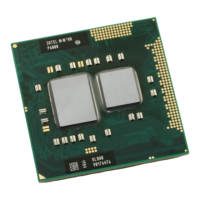Errata
22 Specification Update
BG12. General Protection Fault (#GP) for Instructions Greater Than 15 Bytes May Be
Preempted
Problem: When the processor encounters an instruction that is greater than 15 bytes in length, a
#GP is signaled when the instruction is decoded. Under some circumstances, the #GP
fault may be preempted by another lower priority fault (e.g., Page Fault (#PF)).
However, if the preempting lower priority faults are resolved by the operating system
and the instruction retried, a #GP fault will occur.
Implication: Software may observe a lower-priority fault occurring before or in lieu of a #GP fault.
Instructions of greater than 15 bytes in length can only occur if redundant prefixes are
placed before the instruction.
Workaround:None identified.
Status: For the steppings affected, see the Summary Tables of Changes.
BG13. General Protection (#GP) Fault May Not Be Signaled on Data Segment Limit
Violation above 4-G Limit
Problem: In 32-bit mode, memory accesses to flat data segments (base = 00000000h) that
occur above the 4-G limit (0ffffffffh) may not signal a #GP fault.
Implication: When such memory accesses occur in 32-bit mode, the system may not issue a #GP
fault.
Workaround:Software should ensure that memory accesses in 32-bit mode do not occur above the
4-G limit (0ffffffffh).
Status: For the steppings affected, see the Summary Tables of Changes.
BG14. LBR, BTS, BTM May Report a Wrong Address When an Exception/Interrupt
Occurs in 64-bit Mode
Problem: An exception/interrupt event should be transparent to the LBR (Last Branch Record),
BTS (Branch Trace Store) and BTM (Branch Trace Message) mechanisms. However,
during a specific boundary condition where the exception/interrupt occurs right after
the execution of an instruction at the lower canonical boundary (0x00007FFFFFFFFFFF)
in 64-bit mode, the LBR return registers will save a wrong return address with Bits 63
to 48 incorrectly sign extended to all 1's. Subsequent BTS and BTM operations which
report the LBR will also be incorrect.
Implication: LBR, BTS and BTM may report incorrect information in the event of an exception/
interrupt.
Workaround:None identified.
Status: For the steppings affected, see the Summary Tables of Changes.

